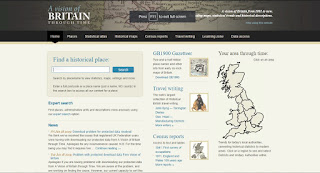National Library of Ireland
Now that the summer holidays are here, I have friends
travelling around Britain who will doubtless be spending at least some of their time ancestor-hunting. This has reminded me that although I’ve
blogged before about using your local public library, there are four well-kept secrets around the UK and Ireland that can help you
grow your family tree, also for free: our national libraries.
Here’s a short introduction to each of these great institutions. They have countless resources which a visit
to their websites can fully explain, so here are just a few stand-outs from
their collections, as well as some tips that apply to all of the national libraries. Anybody can join; you don't have to live locally.
The first of these, and probably the most well-known, is the
British Library in central London. As well as providing
visitors with reference materials, they have one of the largest collections of
oral histories in the world. It’s not a well-used
source of genealogical information, but before literacy was quite as widespread
as it is now, families passed on details of their ancestry by word of mouth. Recorded memories of past times and
communities preserve ways of life that our ancestors would have known.
The BL is also home to the India Office collection – this includes both official records such as births, and personal papers of individuals and
families with a connection to India. This
collection is a must to investigate if someone in your family worked for the
East India Company, or was in military service in the subcontinent.
The National Library of Scotland in Edinburgh, although its genealogical focus is on Scottish families, has an
excellent online presence in their UK Map Images which anyone researching British places will find invaluable. NLS e-resources,
including newspaper collections, are freely available to Scottish residents. And their guide to Scottish family history is well worth a look, too. Their onsite collections include the papers of many Scottish landowning families, so if your ancestors worked for them or crofted on their lands, you may find them mentioned in correspondence or rentals.
Located in Aberystwyth, the National Library of Wales describes itself as ‘the main repository for family history research in Wales’. Like other libraries, some of its holdings, such
as census returns, are widely available elsewhere, but the unique archives,
manuscripts, newspapers, nonconformist church records, and tithe maps are not. The archives at NLW hold many estate and
family papers which will provide insight not only into the lives of the landed
gentry, but to their tenants and employees as well.
The National Library of Ireland in Dublin offers fantastic on-site support for family
historians. Its free Genealogy Advisory
Service provides an opportunity for you to sit down with a specialist who will
give you tailored pointers on where and how to continue your research. Useful for both beginning and experienced genealogists,
this is best done at the start of your visit so that you can take advantage of
the resources the library holds, including Catholic parish registers, estate
papers, and maps. No appointment is necessary
for this service and its hours are posted on the NLI website.
Registration at each of the national libraries is essential
and you will be issued with a reader’s pass.
Check the requirements for the library you plan to use and see if you
also need to register online in advance of your visit. Information sessions and talks are part of
the work these libraries do to promote their services, and it may be useful to
time your visit so that you can take advantage of one of these. Another bonus is free in-house access to subscription websites such as FindMyPast, the British Newspaper Archive, or
Ancestry.
As with any record office, you should search the library’s online
catalogue before your trip to determine what they have that will help your research.
Search for place and family names to discover what the library holds about the
subjects you are interested in. This is particularly
crucial if the material you want to look at is stored off-site and needs to be
ordered well in advance of your visit – or even just to save you a long wait
while your order is retrieved from the depths of the repository. You may want to contact library staff with
any questions you have about your planned research.
Exhibitions and displays are also part of national libraries;
great for when your brain and eyes need a break from research for a bit. And of course there are cafés and restaurants and the inevitable
gift shops to enjoy. But don’t be too
tempted by the expensive wares on sale in the British Library shop!









